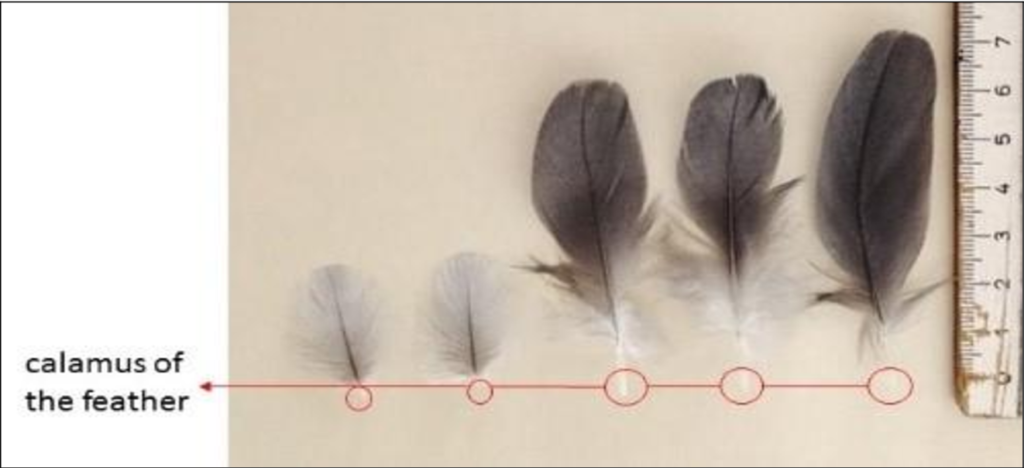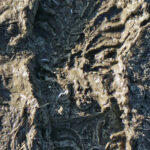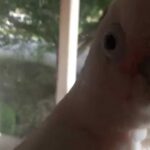A plucked feather is forcibly removed from a bird, while a molted feather is naturally shed during the bird’s molting cycle. Plucked feathers typically indicate human intervention or stress in birds, whereas molted feathers are part of a healthy growth process.
Understanding the difference between plucked and molted feathers is crucial for bird owners and enthusiasts. Birds naturally lose old or damaged feathers in a process called molting, which allows for the growth of new feathers that are crucial for flight and insulation.
Molting occurs in response to hormonal changes and seasonal rhythms. Conversely, plucking involves the removal of feathers by external forces, potentially including the bird itself due to stress, illness, or behavioral issues. Both scenarios present differently and require separate considerations regarding the welfare and care of the bird. Careful observation can determine if a bird’s feather loss is a healthy molt or a concerning sign of distress. Identifying the cause of feather loss is key to ensuring the well-being and longevity of these avian companions.
Introduction To Feather Types
Birds are fascinating creatures with beautiful coats of feathers. But not all feathers are alike. Some get plucked, while others fall out naturally. Let’s explore the world of feathers, understanding the differences between plucked and molted ones. This insight is essential for bird owners and enthusiasts alike.
Plucked Feathers: A Quick GlancePlucked Feathers: A Quick Glance
Plucked feathers are not a usual sight, yet can occur due to stress, boredom, or health issues in birds. Finding them indicates a problem that needs addressing. Unlike natural shedding, plucked feathers can leave bare spots or damage the feather follicles.
- Signs of plucking include:
- Irregular bald patches
- Broken feathers
- Birds appearing distressed
- Common reasons for plucking:
- Poor diet
- Lack of enrichment
- Medical conditions
Molted Feathers: Natural Shedding
Different from plucking, molted feathers fall naturally in a cycle for growth and health. Birds shed old feathers to make way for new growth, ensuring their coats stay strong and functional. Molting patterns can vary by species and time of year.
| Characteristic | Molted Feathers |
|---|---|
| Appearance | Even feather loss across the body |
| Timing | Usually occurs seasonally |
| Bird Behavior | Birds remain calm and behave normally |
Observing a bird’s molting process offers a window into its overall well-being. It’s a natural, healthy process where care and nutrition are vital for a smooth transition.
The Anatomy Of A Bird’s Feather
Understanding the intricacies of a bird’s feather reveals much about its life cycle. Let’s delve into the dynamic world of plumage where each feather tells a story of growth and survival. Whether naturally shed or plucked, feathers offer clues about a bird’s health and habits.
Feather Components And Structure
| Component | Description |
|---|---|
| Vane | The vane is the broad, flat area on either side of the shaft. |
| Shaft | It’s the central part of the feather where barbs connect. |
| Barbs | These are rows of branches that come off the shaft. |
| Barbules | These tiny hooks latch barbs together for a smooth surface. |
| Quill | The quill anchors the feather to the skin. |
The structure of a feather depends on its purpose. Flight feathers are sleek and sturdy. Downy feathers are soft and trap air to keep the bird warm.
Growth Patterns And Feather Health
- Feather growth starts with a blood-filled quill called a pin feather.
- As a feather matures, the blood recedes and the shaft hardens.
- Healthy feathers are smooth, vibrant, and intact.
- Damaged feathers can hint at nutritional issues or diseases.
Molting is the natural replacement of feathers. During molting, a bird can look patchy. Frayed or missing feathers need attention. They can signal stress or damage. By contrast, feathers plucked by the bird may suggest discomfort or behavioral concerns.
Each feather’s condition, from shiny and sleek to tattered and missing, offers a glimpse into the bird’s life. Birds rely on their feathers for flight, temperature control, and even mate attraction. Thus, feather care is vital for bird wellbeing.
Molting Process In Birds
Every bird faces a natural makeover period known as molting. This renewal leaves them with fresh, strong feathers. Understanding why it happens is fascinating. Let’s explore this natural occurrence.
Why Birds Molt
Flying becomes safer and easier with fresh feathers. Over time, feathers wear out. Molting replaces these worn feathers. Birds also molt for seasonal camouflage and to prepare for mating displays. This ensures their survival and ability to attract mates.
Stages Of The Molting Cycle
- Pre-Molt: Birds prepare for molting by increasing their food intake. This helps them gather energy for the process.
- Active Molting: Old feathers fall and new feathers begin to grow. This phase can affect a bird’s ability to fly and stay warm.
- Post-Molt: Once new feathers are fully grown, birds return to their regular activities with a fresh plumage.
Molt patterns can be complete, partial, or in sequences. Complete molting replaces all feathers. Partial molting only changes some. Sequential molting happens in stages.
A bird’s health, age, and species influence its molting patterns. This ensures they’re ready for challenges ahead.

Credit: htrchickens.com
Plucking Behavior In Birds
Birds often showcase a natural and healthy process called molting, where they shed old feathers for new growth. But when birds start pulling out their feathers, it’s a sign of distress. This behavior is known as feather plucking.
Reasons Behind Feather Plucking
Feather plucking is a symptom with many causes. Birds may pluck their feathers for various reasons.
- Health issues: Skin infections or parasites can irritate birds.
- Nutritional deficits: Lack of vitamins can cause discomfort.
- Environmental factors: Poor lighting or small cages can trigger plucking.
- Behavioral factors: Boredom or lack of social interaction may lead to the habit.
Emotional And Physical Impacts On Birds
Feather plucking impacts birds deeply. It affects them both emotionally and physically.
| Emotional Impact | Physical Impact |
|---|---|
| Stress and anxiety | Skin damage |
| Depression | Infection risk |
| Lack of confidence | Feather growth issues |
Visual Differences
The appearance of feathers can tell a story. When you find a feather, you might wonder: did it fall naturally or was it plucked? Here we’ll pinpoint the key differences that reveal the feather’s history.
Examining The Base Of The Feather
Take a look at where the feather once connected to the bird. A molted feather will have a clean, smooth base. It shows where it naturally detached. A plucked feather, on the other hand, might look rough or torn. This is where it was pulled from the bird’s body.
| Molted Feather | Plucked Feather |
|---|---|
| Smooth base | Rough or jagged base |
Shape And Conditions Of Feathers
Study the feather’s shape and condition. Molted feathers usually keep their shape well. They appear clean and undamaged. Plucked feathers often look bent or damaged. Some may have missing parts.
- Molted Feathers:
- Retain original shape
- Look clean with no damage
- Plucked Feathers:
- Show signs of force
- Possibly bent or torn

Credit: www.researchgate.net
Texture And Quality Contrast
When exploring the nuances of bird feathers, keen differences emerge between plucked and molted feathers, particularly in texture and quality.
Feeling The Feather: Smoothness Vs. Roughness
Touching a molted feather reveals a unique texture. Birds release these feathers naturally. Molted feathers often retain a smoother feel. This smoothness indicates a healthy life cycle.
Contrastingly, plucked feathers feel different. They might seem rough due to the unnatural removal process. Stress or discomfort often causes birds to pluck their own feathers. This makes the feathers feel coarser.
Durability And Strength Comparisons
| Feather Type | Durability | Strength |
|---|---|---|
| Molted Feather | High | Strong |
| Plucked Feather | Lower | Compromised |
- Molted feathers showcase resilience.
- They endure environmental challenges before falling off naturally.
- Plucked feathers, on the other hand, may have weakened quills.
- Their structure could be damaged due to forced removal.
Contextual Clues And Bird Behavior
Understanding ‘Plucked Feather Vs. Molted Feather’ requires keen observation. Birds shed feathers in natural cycles, known as molting. Alternatively, plucking signifies a potential issue, such as stress or disease. Recognizing these signs improves bird care and conservation.
Observational Tips
Spotting the difference starts with careful observation.
- Check the ground below perches for feathers.
- Examine feather condition. Broken feathers could imply plucking.
- Observe for bald patches. Uneven loss suggests plucking.
- Molted feathers often appear at certain times. Check seasonally.
Behavior Patterns: Plucking Vs. Molting
Molting and plucking can look similar but involve different behaviors.
| Behavior | Molting | Plucking |
|---|---|---|
| Appearance | Even feather loss | Patchy, uneven |
| Season | Regular intervals | Any time |
| Bird’s Action | Calm | Agitated, self-pecking |
Molting birds appear calm and continue regular activities. In contrast, plucking birds may show signs of agitation and even self-harm. Watching for these patterns is crucial for bird health.
Implications For Avian Care
Understanding the difference between plucked and molted feathers is crucial for optimal avian care. Birds naturally molt feathers to replace old ones. Conversely, feather plucking often indicates stress or health issues. It’s important to know how to care for birds during these events.
Caring For A Molting Bird
When a bird molts, it may appear ruffled or scruffy. This process is normal and necessary for their health and vitality. Here are some ways to help:
- Ensure a nutrient-rich diet to support feather growth.
- Provide extra baths or misting to help with itchy skin.
- Reduce stress by keeping the environment calm.
Maintain a regular pet-care routine but allow for more rest as your bird manages energy differently during molting.
Addressing Plucking And Its Causes
Feather plucking is a behavior that requires immediate attention. Look for signs of anxiety, environmental factors, or health issues as possible causes.
| Cause | Action |
|---|---|
| Stress | Create a calm environment, minimize loud noises. |
| Illness | Consult a vet promptly for a health check. |
| Boredom | Provide engaging toys and activities. |
Immediate response to plucking can prevent further damage to your bird’s feathers and well-being.
Professional Insights And Interventions
The health of a bird can shine through its feathers. Understanding the differences between plucked and molted feathers is key to maintaining their wellbeing. Plucking can indicate stress or health issues, while molting is a natural process. Professional insights and interventions are critical for addressing any feather-related issues your avian friend might face.
When To Consult An Avian Veterinarian
It’s not always easy to tell when a bird needs expert care. Here are signs that it’s time to seek guidance:
- Excessive feather loss not aligned with normal molting cycles.
- Bare patches on the skin where feathers should be.
- Behavior changes such as aggression or listlessness.
- Changes in appetite or droppings.
Treatments And Remedies For Feather Issues
Once a vet pinpoints the issue, they might suggest several treatments:
| Problem | Treatment |
|---|---|
| Parasites | Medicated baths or oral medications. |
| Nutritional deficiencies | Dietary changes or supplements. |
| Stress or anxiety | Environmental changes or behavior modification. |
| Self-mutilation | Protective collars or distraction techniques. |
Regular check-ups and early interventions prevent most issues. Keep your bird’s environment enriching and diet nutritionally complete for a happy, healthy life.

Credit: seabrookislandbirders.org
Conclusion
Understanding the differences between plucked and molted feathers can enrich your appreciation for bird behaviors. By recognizing the telltale signs, you become a more observant birdwatcher. Care for injured birds by distinguishing between these two conditions improves. We hope this guide enhances your avian knowledge.
Happy birding!
Ryan Everhart is a passionate bird enthusiast and blogger, primarily writing on his website, Avian Whispers. His journey into the world of bird blogging began with a deep interest in parrots, a species that captivated his attention for their intelligence and social behavior. Over time, his content expanded to cover a broader range of bird species, offering insights into bird behavior, care, habitats, and conservation.
Ryan is dedicated to educating his audience, which includes both new bird owners and seasoned enthusiasts. His writing is filled with personal experiences, expert knowledge, and practical advice on bird care. Through Avian Whispers, he aims to foster a deeper appreciation for birds, emphasizing their role in nature and the joys of having them as pets.
Starting with articles focused on parrots, Ryan’s work now encompasses a diverse range of topics such as feeding, training, habitat enrichment, and bird health. His love for birds extends beyond parrots, diving into various avian species. His informative and heartfelt writing reflects his commitment to the well-being of birds and the desire to help others connect with these creatures.
As a growing voice in the bird blogging community, Ryan strives to provide a platform where bird lovers can learn, share experiences, and connect over a shared passion for avian life. His blogs are not only educational but also serve as a reminder of the importance of protecting and nurturing the bond between humans and birds.




